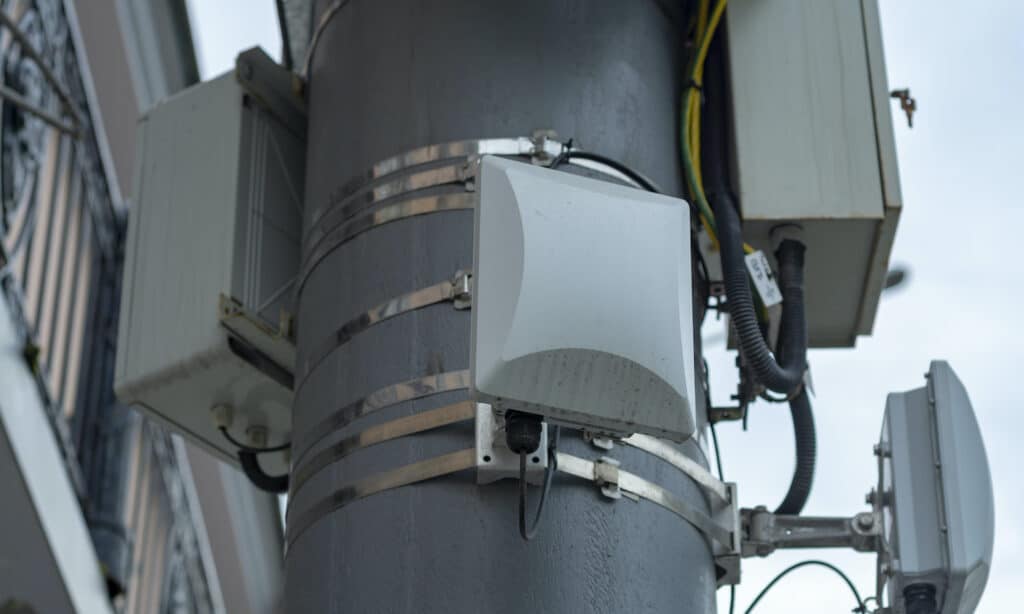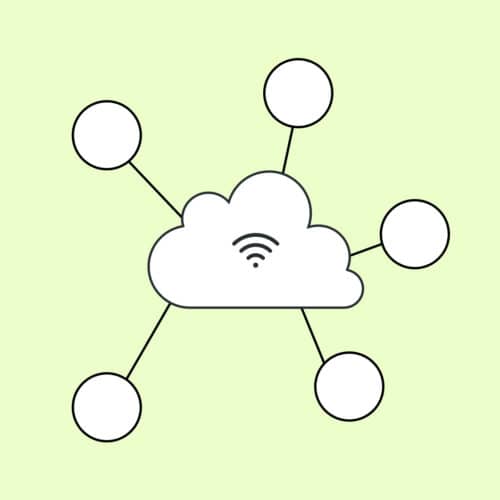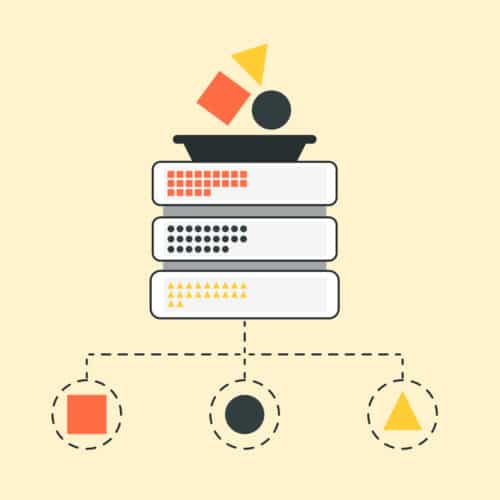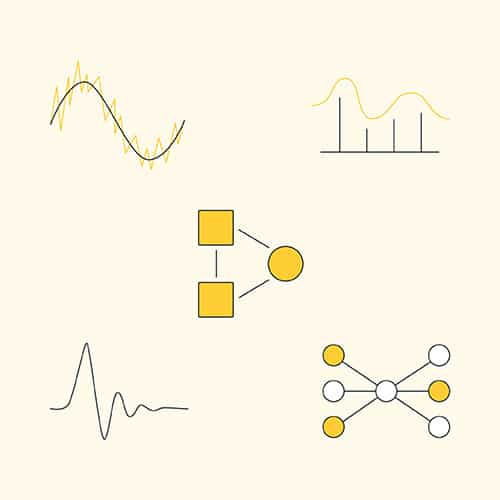WHITEPAPERS
Innovation at the Edge
Exploring the complexities of 5G, IoT, and edge computing and how they work together
Life on the Edge
Edge computing can dramatically improve the speed, security, and performance of applications by shifting the location of computing from the cloud to the device. For companies building Internet of Things (IoT) technologies, artificial intelligence applications, and using 5G networks, edge computing is something critical to consider on each project. Edge computing can provide better privacy, reliability, and consumer experiences, delivering on shifting expectations and providing better products and services to customers.
What Is Edge Computing?

At its core, edge computing is about location. Where is your data processed? What does the location mean for computing performance, latency, and security?
Edge computing is a paradigm shift from cloud computing. In cloud computing, data is collected from a computer or an IoT device. It’s stored and processed remotely in the cloud computers. Cloud servers are the hubs of collection, storage, and processing. Applications on the user end – computers and IoT devices – ping the cloud to access information and enable functionality.
Cloud computing grew out of necessity. Cloud architecture allowed for the deployment of technology on the edge – mobile devices, IoT devices – that did not have the computational power or storage capabilities necessary to collect, compute, and store needed information. Limited hardware capabilities and functionality required the need for cellular or Wi-Fi networks to send information collected on local devices to networked, cloud-based servers where the vast and complex functionality was possible.
Edge computing changes the modality, flipping it on its head. Edge computing shifts the processing to the device or computer itself. Computing happens at the device level, not in the cloud itself.
Advancements in the miniaturization of processing technology and storage capacity provide an opportunity that was not possible even a few years ago. IoT devices today are far more powerful – able to collect, store, and process more information than ever before.
Those technological advances provide extraordinary opportunities for companies to advance their networks and relocate processing from the cloud. Bringing processing closer to where the data is collected and stored can have significant benefits.
There are fewer trips for data to take. Edge computing eliminates the back and forth of your data. Instead of collecting and transmitting information from devices to the cloud, where processing happens, then sending it back to the device, the computations can happen locally. By managing computations at the network’s edge, information can be analyzed and applied by users closer to the source.
“Edge technologies make it feel like every device is a supercomputer,” notes a recent Federal Communications Commission (FCC) white paper on 5G edge computing. “Digital processes become lightning fast. Critical data is processed at the edge of the network, right on the device.”
When to Use Edge Computing & Examples

Whether or not to incorporate edge computing into your strategy, and to what degree, depends largely on your use case.
Do latency and user privacy matter a great deal for your product and users? What’s the cost and compute power of your device? How easy or difficult will it be for your device to access the cloud once it’s out in the field?
These are all questions to ask when exploring edge vs. cloud on your IoT project, and these examples illustrate some of the nuance.
Loxx Boxx
On the IoT project Very did for Loxx Boxx, the team had a good use-case for edge computing. The issue on the project was that the valid codes for opening the box were stored in the cloud and updated frequently (manually based on users providing access to other users, and automatically through package shipping/tracking updates).
The device was battery-powered, and in order to conserve battery, it did not maintain a constant cloud connection. In order to provide a snappy “opening experience”, we needed to avoid a cloud connection before opening the box for as many use-cases as possible.
The solution was to momentarily wake the device on an hourly basis, and sync a local copy of the valid access codes to the device. This meant that for most “opening experiences,” the box would know that a code was valid without going through the cloud connection/querying step, thus allowing the box to open much more quickly. Of course, there was a fallback to check in the cloud if the code provided by the user was not in the local database.
Benefits of Edge Computing for Enterprises

For enterprises and industrial companies, there can be considerable advantages to edge computing over the cloud, ones that will also have a direct impact on the demand for 5G wireless technologies in the coming years.
1. Speed
Edge computing can provide improved processing speed, reducing latency, which can be critical for companies in industrial sectors where lag can cost millions of dollars in lost opportunities.
IoT edge computing means that computations can be done locally, either on devices themselves or on nearly edge data centers, not on remote cloud servers. The data simply does not need to travel as far. That means faster speeds, faster results, and better experiences for users and customers alike.
Data does not travel instantaneously. There is still the need for transmission and traffic jams can happen. The sheer volume of data being transmitted means there are naturally going to be lags in transmission. Workloads on cloud computers also have capacity limits. Even at ultra-fast speeds, milliseconds matter.
Lags of milliseconds can mean the difference between life and death for a healthcare company or lost sales opportunities for retailers and traders. Lags mean losses not only in revenue but also in credibility, potential, and brand value. Data-driven companies that depend on the fast computation of information for delivery, especially on mobile devices, need quick responses.
2. Reliability
Those aforementioned trips from devices to the cloud, and the traffic jams that can ensue, mean you are at the whims of congestion and performance. Imagine algorithms stored in a cloud-based application that process information and deliver inputs back to your local device. Companies can reduce the distances data have to travel and the potential impact of system or network issues.
There are countless issues that can arise during the process of sending data, processing it, and sending results back. With those same algorithms stored on local devices, there is more direct application of computing processes. There is less risk of a network outage or issue affecting performance for your locally delivered services. IoT edge computing devices will still operate even if centralized network problems emerge.
If there is a system-wide issue, the number of local edge computing data centers means less risk to local operations. Technicians can re-route data to ensure that there is continuity of services, even during an incident, whether a natural disaster or a cyberattack.
Designing your network architecture to incorporate edge computing solutions means your results are more reliable. Troubleshooting is easier to manage and problems are resolved faster (or never materialize).
3. Scalability
Cloud computing has allowed businesses to collect, analyze, and use data in unprecedented volumes. More deployed IoT devices means massive amounts of data. Cloud computing has long touted scalability as a core benefit. As the amount of data collected and used grows, cloud solutions can adapt quickly without the need to wait for the purchase and installation of on-premises servers.
Edge computing offers similar scalability benefits. It allows for rapid increases in demand for computing data space. Edge computing, along with advancements in IoT technology, means that computing, analytics, and storage can be located nearer to the end users. Computing can be scaled quickly. The difference with edge computing over the cloud is that this rapid growth in capacity is situated locally, not virtually. Gone are the days when the need for massive, local data centers was critical for rapid expansion. In addition, companies no longer incur the considerable expenses for that infrastructure, with no need for the space, power, and cooling costs associated with data centers.
By keeping processing on the local devices, companies also reduce their growth costs for additional bandwidth. As new devices are added, companies do not tax existing networks or require more bandwidth to transmit information in multiple directions.
4. Data Security and Privacy
IoT edge computing can keep data safer. As privacy concerns mount, government entities, industries, and customers expect new, stringent standards for data. Laws continue to be passed at the state, provincial, national and regional level requiring companies to document their approaches to data security.
Contracts, especially with U.S. government agencies, now require stricter data controls and privacy standards, with documented mechanisms for how customer and consumer information is used, transmitted, stored, distributed, and sold.
Edge computing keeps more data local. That means less or less frequent volume of data transmission, reducing the risk of interception or compromise. Local or near-local storage and manipulation of data means data remains still, not in transit, longer. That makes the deployment of cybersecurity measures easier and clearer, providing fewer opportunities for corruption, theft, destruction, or hostage-taking of vital data.
Caveats
It’s important to note that there are also new and different risks with IoT edge computing over IoT and cloud computing. The potential attack surface is much larger with thousands or millions of connected devices in use worldwide. Edge computing locations, for example, run the risk of tampering and theft. And with intermittent network connectivity, security protections must be in place even when devices are disconnected from a central network or management console.
There cannot be a one-size-fits-all approach to security, either. Some devices will have limited computing capacity. A value and needs assessment is necessary to ensure that unnecessary costs are not incurred for devices that carry low risk of intrusion.
5. Versatility
Edge computing allows for more versatility in the development of new products and services, access to new markets and customers, and use of data and applications.
Local edge data centers provide businesses with new opportunities in new markets without the need to invest in expensive expansion of their physical infrastructure. Edge data centers also allow for better delivery of services and support with organizations that are physically distant from customers, with little risk of latency being an issue. Companies can be nimble and flexible as new business opportunities emerge.
6. Access to Information
IoT computer devices with edge computing enable companies to gather massive amounts of data and information. With enhanced computing and transmission capabilities stored within these devices, businesses do not need to rely on customers to log on or interact with company servers. The devices can continuously collect information. They are always on, always collecting and always generating information that can be sent for analysis.
This always-on modality provides businesses with deeper insights into customers, their use of technologies and applications, and their unmet needs. By collecting both structured and unstructured information, devices with edge computing can help create more accurate buyer and user personas, identify usage trends, and bring to market new and revised products faster that are more relevant to consumer needs. Better products and services that respond to customer desires means more potential revenue sources, faster innovation, and digital transformation.
Edge Computing and 5G Technology

The fifth generation (5G) of cellular data technology is here. While the first 5G networks were installed in 2018, the number of 5G-enabled devices became widespread in 2019 and 2020.
5G is, in many ways, analogous to edge computing. It delivers faster speeds and less latency in the transmission of data over cellular networks. Its maximum data transfer rate is 2.5 gigabytes per second, which is more than 20 times faster than LTE cellular networks.
Frequency Options in 5G
One of the main differences in 5G technology is that it uses three different frequency bands. Each has its own advantages and best uses. The more options for airwaves gives cellular carriers more flexibility and opens up the possibilities to use high-band frequencies that were not available with 4G.
The three airwave bands are:
1. Low-band frequencies
These bands operate at frequencies between 600 and 2,000 MHz. They offer download speeds of between 30 Mbps and 250 Mbps. They are among the oldest frequencies used by cellular networks and television carriers. They can travel major distances but the channels themselves are not very wide. That means they are relatively slow and feel a lot like 4G. They are best used in rural areas with long distances between cellular towers.
2. Mid-band frequencies
They broadcast at frequencies between 1-10 GHz. That covers most of current Wi-Fi and cellular frequencies in use today. These are expected to be most-used wireless network airwave bands and will be the workhorses of 5G technology. They have good range from towers of several miles and deliver download speeds of between 100 and 900 Mbps.
3. High-band frequencies
Also known as millimeter wave, this is the newest and most exciting aspect of 5G. These airwaves are in the 20-100 GHz range. They are very short-range frequencies, with ideal distances of 800 feet to a mile from towers. It’s an excellent choice for applications like sports arenas, city centers, and public gathering areas. High bands have been used previously for backhaul transmissions from base stations to remote connections, but never before for consumer applications.
5G will become the norm for applications by 2021 or 2022, according to a recent article in PC Mag. 5G offers three main improvements over LTE and 4G cellular networks:
- Larger channels to accelerate data transmission
- Lower latency
- The ability to connect more devices at the same time
All three of these advantages are why the synergies of edge computing, the IoT and 5G are so essential.
Leveraging Opportunity
The opportunities are significant to leverage the convergence of these three emerging technologies.
5G provides far more bandwidth opportunities. That means it will be much easier to send high volumes of data. Like edge computing, 5G helps with latency, allowing for a distributed architecture structure that lets data move not only at higher volumes but more efficiently.
5G, which will operate on a series of network nodes, allows you to keep more data on the edge. There’s no need to send all that data back to a centralized server and the 5G transmission speeds mean information that is sent or delivered gets there faster.
Edge computing and 5G networks should also solve the “last mile” problem that has plagued cellular delivery in some areas. The last-mile problem means that as data gets closer to the end user, sub-optimal connections create data bottlenecks. Edge solutions should resolve those issues for many.
Reducing latency is the driver for both of these technologies. The FCC notes that by combining edge computing with 5G networks, round-trip time can be reduced by up to two orders of magnitude. That difference in speeds provides a dramatic opportunity for companies to deliver new cloud applications.
New technologies will continue to influence these new opportunities. Drone applications, smart car and vehicle-to-everything (V2X) technologies, robotics, and virtual reality can all be delivered more efficiently and effectively with transmission, technology, and processing that’s closer to the end user.
The widespread deployment of 5G is one of the factors behind a large projected increase in edge computing in the next five years. According to one estimate, the global market for edge computing is projected to reach $8.8 billion in 2025 from $2.5 billion in 2018.
The introduction of the 5G network (and) various IoT software platforms and languages are expected to provide significant opportunities for market growth in the coming years.”
Valuates Report
As the number of IoT devices has grown, so has the amount of data being generated. That’s driven considerable growth in demand for edge nodes, devices, and localized data centers.
Among the shifts that 5G provides is in business models themselves. Many business decisions related to data transfer have been made based on reducing latency, keeping data on local devices longer, and waiting for times of lower traffic before collecting information.
With 5G, there’s a new opportunity. Businesses will need to determine how to leverage the financial value of information collected, stored, and analyzed on the “things” themselves. For example, can businesses derive value from data stored and processed on the device before passing that information on to a central hub?
5G is likely to accelerate the growth of edge computing. With faster real-time processes, new solutions will be needed to leverage the information provided from and to IoT connected devices. 5G can be a driver not just back to central servers, but also for new business services and products that are sent to other users and customers.
As 5G and edge computing evolve, companies will also need to invest in new types of IoT devices. One of the key drivers of advanced business growth with 5G and edge computing will depend on the capabilities of the devices themselves. Will businesses want to create and deploy these devices themselves, or buy or lease devices from other companies?
Security will continue to be a concern. As noted, as the potential attack surface increases, so too will the risk. Distributed security models will need to be developed to address growing networks of IoT devices, and those security devices and methods will need to adapt to the capabilities and functionality of still-evolving 5G networks.
Creating an Edge Computing Strategy with IoT and 5G

A recent Gartner study recommends some of the processes organizations should follow in order to optimize edge computing in an era of growing IoT and emerging 5G networks.
The recommendations include:
- Creating a living strategic plan for edge computing that uses an approach and framework that balances multiple requirements with manageable guidelines
- Ensuring that proof-of-concept deployments show how to manage real-world scaling for computing, connectivity, management, and security
- Minimizing the attack surface by building edge computing hardware, software, applications, data, and networking with built-in security and self-protection
- Investing in technologies that automate edge-based data management and governance as much as possible
- Protecting network communications to and from the edge
- Protecting data analyzed and stored at the edge, including for privacy and compliance
- Controlling edge device authentication and trust assurance
- Leveraging existing data policies, roles, and stewardship to apply to edge devices
- Investing in data management, integration, analytics, and governance applications for data stored on the edge that may be different from that stored in traditional solutions
Edge computing architectures need to be built with 5G and IoT in mind. The technologies go hand in hand, now more than ever. That goes not only how they are used but how they should be structured and developed from the beginning.
Edge computing also needs to be a choice. Some customers may prefer that some services are still delivered using cloud or even on-premises solutions. In some cases, regulations and mandates may require more stringent measures or using the older, more established solutions. Businesses need to be flexible in how they develop and offer these solutions.
Gaining an Edge
At Very, we help companies with innovative IoT solutions designed to deliver products and services that delight and amaze. We embrace the technological opportunities that 5G IoT edge computing offers to our customers.
To learn more about our IoT product design & development services, contact us today.










